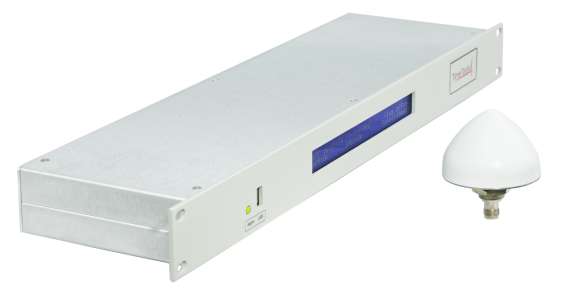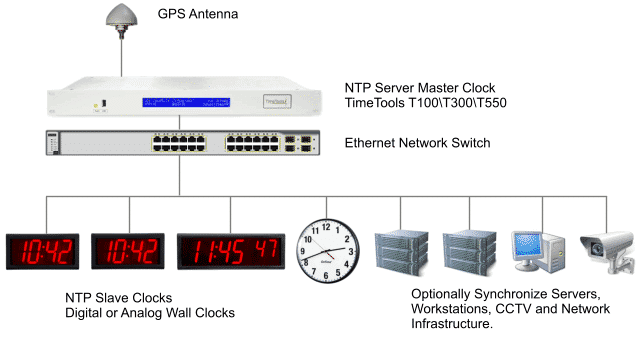A GPS Master Clock is a computer appliance that obtains precise time from the Global Positioning System (GPS) and provides a synchronization resource to clients. A network master clock provides a time synchronization reference to clients over a local or wide area network. Network Time Protocol (NTP) is widely used by master clocks for network time synchronization.

Master clocks are generally housed in a 19 inch rack-mount enclosure for easy installation in computer facilities. In addition to providing NTP synchronization, they also often provide precisely synchronized digital and analog outputs, such as IRIG-B, 10MHz, 1pps and serial ASCII outputs.
The Need for Synchronized Time
Most computers have real time clocks that keep time even when the appliance is powered down. However, to keep prices low, many manufacturers use inferior, relatively low cost, components. These components tend not to keep very good time and can drift from the correct time at an alarming rate, even after a relatively short period.
Many modern computer systems are distributed systems. They consist of many computers, that make up a working system. Each computer needs synchronized time to ensure events are correctly ordered and processes completed in an orderly manner. Master clocks provide network client computers with an accurate time reference.
GPS Time
The Global Positioning System (GPS) is a constellation of 24 satellites that constantly orbit the Earth. GPS is a US government system maintained by the military. The system provides positioning, navigation and timing services (PNT).
Integrated into each satellite is an ultra-precise atomic clock. Each atomic clock is periodically synchronized to a master clock located at the U.S. Naval Observatory in Colorado. Each atomic clock is stable enough to maintain accuracy to 1 second in 300 million years.
The GPS system is a truly global system. By utilizing a relatively low-cost antenna and receiver module, GPS signals can be received anywhere on the face of the Earth.
GPS Signal Reception
Receiving GPS signals requires a separate antenna connected to the receiver by a length of coaxial cable. Ideally, a GPS antenna should be located outdoor, with a clear 360 degree view of the sky. However, window or even indoor located antennas can sometimes provide adequate signal reception.
GPS antennas are generally weather-proof and designed for mounting outdoors, often on a roof-top. The coax cable used depends on the gain of the antenna and the signal loss associated with the cable type. A typical 40dB antenna can utilize in excess of 100m low-loss LMR400 or equivalent cable. Lower quality, higher loss, cable, such as RG58, will have a much shorter maximum cable length.
Surge suppressor or protection devices should be installed where GPS antennas are located outdoors. These protect expensive equipment connected to the antenna from potential lightning strikes and other electrical surges.
For very long cable runs, an amplifier can be used boost GPS signals. A GPS amplifier is a small device that sits in-line on the coax cable between the master clock and antenna. It is powered from the master clock, requiring no separate power supply. If required, multiple amplifiers can be fitted at intervals along the cable to further boost signals.
The Network Time Protocol (NTP)
The Network Time Protocol (NTP) is a standard Internet protocol for distributing precise time to computers over a network. NTP is a hierarchical protocol. At the top of the hierarchy is a Stratum 1 time server that obtains precise time from a hardware reference clock, such as GPS. Hardware reference clocks are deemed to be Stratum 0. The Stratum level determines the distance from the reference clock. For instance, stratum 7 is 7 levels away from the reference clock. Due to network latencies and timing overheads, generally, the further a client is from a reference clock, the less accurate the client time is. Master clocks rely on NTP to synchronize network attached devices.

GPS Master Clocks with Digital and Analog Time Code Outputs
Master clocks may provide a number of digital and analog time code outputs. The most common time code outputs are IRIG-B, 10MHz, 1pps and ASCII outputs.
IRIG-B Time Code Outputs
GPS clock systems are commonly equipped with IRIG-B time code outputs. IRIG is the US military Inter-range instrumentation group. IRIG time codes describe standard formats for time transfer. IRIG_B is the probably the most common IRIG time code. It transfers time frames at 1 frame per second with a 100hz bit rate.
10mhz and 1pps Digital Outputs
Laboratory and test equipment often use a 10MHz frequency reference for synchronization. This is generally provided by using GPS timing signals to discipline an OCXO oscillator. The output from the oscillator is then provided on a BNC type RF connector.
One pulse per second (1PPS) outputs provide a short-duration pulse output that is very precisely aligned to the start of each second. A 1PPS output is often provided at 5V (TTL) voltage levels and provided on a RF type connector.
Serial ASCII Time Transfer
ASCII data transfer is conducted over a serial interface, typically RS232. However, other serial interface standards, such as RS422 and RS485 are not uncommon. Many GPS clock systems provide time and date information at periodic intervals via a serial interface. Equipment with serial interfaces can then use the time code for time synchronization. There is no definitive standard for ASCII time transfer. Generally, the format of the time stamp is determined by the manufacturer of the device along with the serial port configuration.
Slave Clocks and Clients
Master clocks can be used to synchronize a wide range of devices. Network Time Protocol (NTP) provides a time reference for servers, workstations, CCTV cameras, DVR’s, time displays and wall clocks. Pulse outputs (10Mhz and 1PPS) are generally used for synchronizing lab and test equipment.
GPS Master Clock Applications
Many computer based applications rely on synchronized time to ensure the correct ordering of events and processes. GPS clock systems provide an accurate reference for synchronizing time clients:
- Security systems rely on CCTV cameras and DVR’s synchronized to a legally traceable time source.
- Broadcast system require accurate timing for the synchronization of transmissions.
- The pharmaceutical industry rely on accurate traceable time to log events and processes.
- Military systems, including radar and communications require accurate time.
- Financial services rely on sub-microsecond timing for high frequency trading.
- Air Traffic Control (ATC) need precise time for orderly operation and logging of events.
Related Articles
Choosing a Master Clock
Master Clocks: A Guide to Master-Slave Time Clock Systems
What is the GPS Clock?
Additional Resources
Wikipedia Master Clocks Page
Time Systems and Dates – GPS Time
Time References in GNSS

| About Andrew Shinton Andrew Shinton is the joint founder and Managing Director of TimeTools Limited. He has a BSc (Hons) degree in Computer Science. Andrew has over 20 years experience of GPS systems and Network Time Protocol (NTP) in the Time and Frequency Industry. |